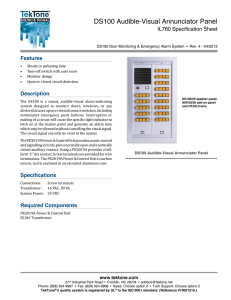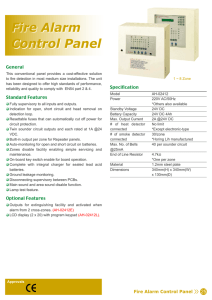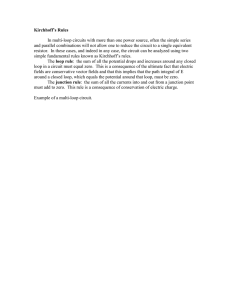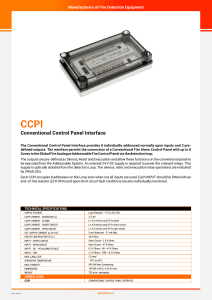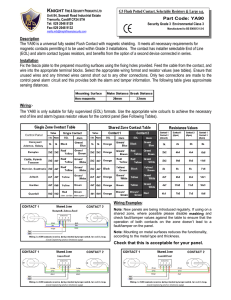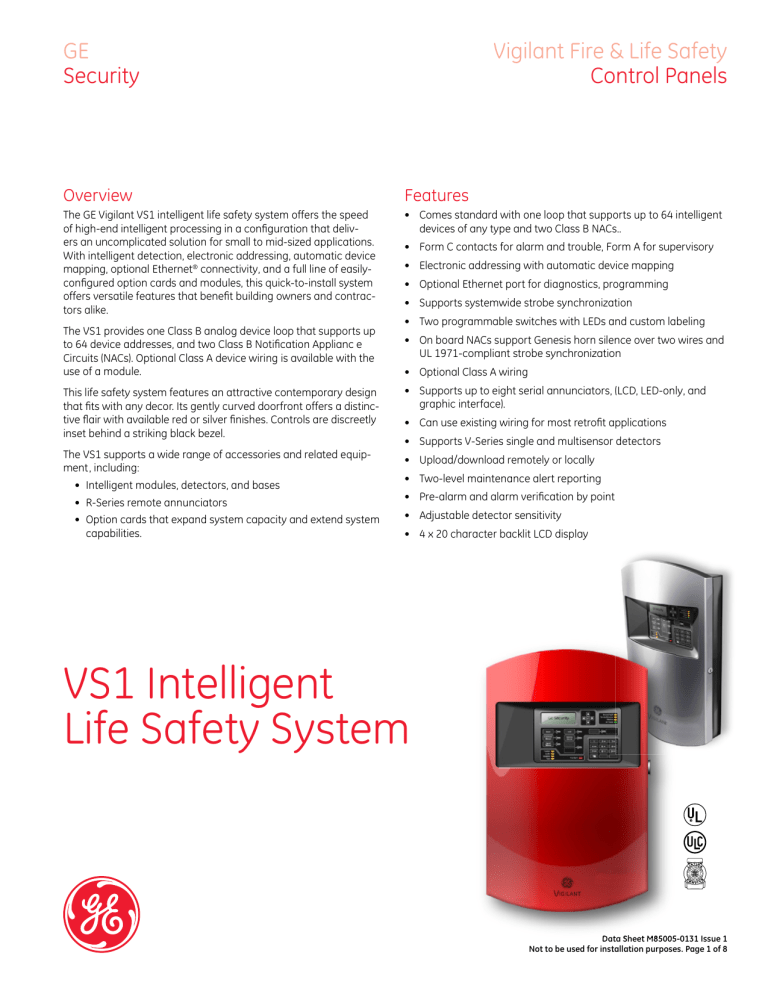
GE
Security
Vigilant Fire & Life Safety
Control Panels
Overview
Features
The GE Vigilant VS1 intelligent life safety system offers the speed
of high-end intelligent processing in a configuration that delivers an uncomplicated solution for small to mid-sized applications.
With intelligent detection, electronic addressing, automatic device
mapping, optional Ethernet® connectivity, and a full line of easilyconfigured option cards and modules, this quick-to-install system
offers versatile features that benefit building owners and contractors alike.
• Comes standard with one loop that supports up to 64 intelligent
devices of any type and two Class B NACs..
The VS1 provides one Class B analog device loop that supports up
to 64 device addresses, and two Class B Notification Applianc e
Circuits (NACs). Optional Class A device wiring is available with the
use of a module.
• Form C contacts for alarm and trouble, Form A for supervisory
• Electronic addressing with automatic device mapping
• Optional Ethernet port for diagnostics, programming
• Supports systemwide strobe synchronization
• Two programmable switches with LEDs and custom labeling
• On board NACs support Genesis horn silence over two wires and
UL 1971-compliant strobe synchronization
• Optional Class A wiring
This life safety system features an attractive contemporary design
that fits with any decor. Its gently curved doorfront offers a distinctive flair with available red or silver finishes. Controls are discreetly
inset behind a striking black bezel.
• Supports up to eight serial annunciators, (LCD, LED-only, and
graphic interface).
The VS1 supports a wide range of accessories and related equipment, including:
• Upload/download remotely or locally
• Intelligent modules, detectors, and bases
• Can use existing wiring for most retrofit applications
• Supports V-Series single and multisensor detectors
• Two-level maintenance alert reporting
• R-Series remote annunciators
• Pre-alarm and alarm verification by point
• Option cards that expand system capacity and extend system
capabilities.
• Adjustable detector sensitivity
• 4 x 20 character backlit LCD display
VS1 Intelligent
Life Safety System
Data Sheet M85005-0131 Issue 1
Not to be used for installation purposes. Page 1 of 8
Application
Programming
The VS1 life safety system is an easy-to-use intelligent solution for
small to mid-sized buildings. Advanced analog technology delivers
the benefits of quick and uncomplicated system installation, while a
clean and easy-to-operatate user interface makes panel operation
and system maintenance quick and intuitive.
VS1 life safety systems are simple to set up, quick to program, and
easy to maintain. The auto programming feature quickly gets the
panel operational using factory default settings. Basic zone and
point settings can be programmed easily through the front panel
interface, so the system is up and running in no time.
The smart choice
Electronic addressing eliminates the tedium of setting dipswitches,
and automatic device mapping ensures that each device resides on
the system at its correct location. Meanwhile, innovative programming features allow the system designer to customize powerful
built-in features to precisely suit the needs of the building owner.
Versatility built right in
Two fully-programmable front panel switch/LED combinations provide an added measure of simplicity. Their slide-in labels take the
mystery out of custom applications, and present a clean finished
appearance.
Perfect for retrofits
The VS1 is particularly well-suited to retrofit applications. All
connections are made over standard wiring – no shielded cable
required. This means that in most situations existing wiring can be
used to upgrade a legacy control panel to V-Series technology without the expense or disruption of rewiring the entire building.
Signals with a difference
VS1 NACs are configurable to fully support the advanced signaling
features of GE Genesis and Enhanced Integrity notification appliances. These devices offer precision synchronization of strobes
to UL 1971 standards. For Genesis devices, enabling this feature
allows connected horns to be silenced while strobes on the same
two-wire circuit continue to flash until the panel is reset.
Clear-cut remote annunciation
Remote annunciation is a strong suit of the VS1. Up to eight annunciators can be installed on a single system. Compatible annunciators include a range of LED and LCD models that provide zone or
point annunciation, as well as common control capabilities.
For more advanced system configuration and correlation groups
programming, the VS1 interfaces to a PC running compatible VS-CU
software. This option offers full system configuration in the familiar
Windows® operating environment. Connection is typically made
to a laptop through the panel’s optional modem or Ethernet port,
which can also be used to connect a system printer.
Among the many advanced features of the VS1 is its optional network card. This module provides a standard 10/100 Base T Ethernet® network connection that permits access to the control panel
from any remote location with the correct communications protocols. The connection can be used to download to the panel from the
VS-CU, or upload and view system reports using the VS-CU.
Available system reports include:
• Correlation groups
• Device maintenance
• Internal status
• System status
• Dialer
•
•
•
•
Device details
History
System configuration
Walk test
Operation
The front panel provides an easy-to-use operator’s interface, as
well as all the necessary controls for front panel programming.
A large back-lit 80-character LCD displays system status, event
details, and programming prompts. Large tactile control buttons are
easy to see in low light conditions, and bright multi-color LEDs offer
at-a-glance status indication.
LCD
display
System
LEDs
00:00:00
01/01/07
Banner
Configurable
The VS1 also supports graphic annunciation with optional RA
Graphic Annunicator interface modules. Each interface provides
common control, indicators, and 32 LEDS. Consult the Ordering
Information section for details.
A complete line of accessories
The VS1 life safety system is supported by a complete line of
intelligent detectors, modules and related equipment. Consult the
Ordering Information section for details.
System
LEDs
Control
buttons
Data Sheet M85005-0131 Issue 1
Not to be used for installation purposes. Page of 8
Control buttons
Button
Reset
ACK/Panel
Silence
Signal Silence
Drill
Remote
Disconnect
Left arrow
Right arrow
Up arrow
Down arrow
Enter
Cancel
Menu
Space
Alphanumeric
keypad
Programmable
buttons
System LEDs
Description
Initiates a system reset.
Silences the panel and remote annunciators during
an active trouble, supervisory, or alarm event and
acknowledges new event activations.
Alarm mode: Silences active notification appliances.
Pressing Signal Silence a second time turns NACs back on.
Initiates a drill confirmation. Pressing drill a second time
turns off the drill function.
Dialer: Disables or enables dialer.
Dialer set to modem only: Disables or enables Central
Station communciation.
Display mode: Moves the cursor to the left.
Menu mode: Toggles between programming selections.
Display mode: Moves the cursor to the right.
Menu mode: Retrieves a programming option’s sub menu
and toggles between a programming option’s selections.
Display mode: Advances to the previous event.
Menu mode: Moves the cursor up.
Display mode: Advances to the next event.
Menu mode: Moves the cursor down.
Display mode: Displays selected event details.
Menu mode: Retrieves a programming option’s sub
menu or jumps to the Save function in the menu.
Entry mode: Enters the selected data into the system.
Display mode: Exits the detailed information display.
Menu mode: Exits the current menu level.
Entry mode: Clears the current entry.
Display mode: Enters the menu mode
Menu mode: Exits menu mode
Enters a space, such as a space between words.
Entry mode: Pressing a button once enters the number
on the button. Pressing the button twice enters the
secondary value.
These buttons can be programmed to control or operate
a device, zone, or Panel NAC. The buttons can be labeled
with a slip-in insert.
LED
Description
Fire Alarm
Trouble
Red LED. On steady when there is an active alarm.
Yellow LED. Flashes when there is a fault on a
monitored circuit or system component, or when a
circuit is disabled.
Supv
Yellow LED. On steady when there is an active
supervisory event.
AC Power
Green LED. On when the panel has AC power.
Disable
Yellow LED. Double-flashes when there is a disabled circuit, alarm relay, or remote annunciator.
Ground Fault Yellow LED. On steady during an active ground fault.
Test
Yellow LED. Flashes when performing an audible
walk test. Steady indicates a silent test.
Monitor
Yellow LED. On steady when there is an active
monitor event.
Service
Yellow LED. Indicates that detector needs servicing.
Detector
Signal
Yellow LED. On steady indicates that NAC circuits
Silence
are turned off but the panel is still in alarm.
Remote
Yellow LED. On steady indicates that the dialer
Disconnect
is disabled or that the alarm relay is enabled or
disabled when the dialer is set to modem only.
Drill
Yellow LED. Indicates that the panel is in drill.
Reset
Yellow LED. Indicates that the panel is resetting.
Panel
Yellow LED. Indicates that the panel has been
Silence
silenced during an active trouble, supervisory, or
alarm event and indicates that new event activations have been acknowledged.
User keys
Yellow LED. Programmable.
Panel Operation Options
Language
Marketplace
AC fail delay
Zone resound
Reset inhibit after
NACs turn on
English or French
U.S. or Canada
Off: Off-premise notification of an AC power failure is
immediate.
1 to 15 hours: Delays the off-premise notification of
an AC power failure by the time period selected.
On: NACs resound each time a device in the zone
goes into alarm even if they were silenced
Off: Inhibits the NACs from turning on again (after
they were silenced) when a second device in the zone
goes into alarm.
Off: Panel reset is operational immediately.
1 minute: Panel reset is inhibited for one minute.
Auto signal
silence
Day start
Night start
Date
Mapping
LCD banner
Event notification
Off: Allows immediate silencing of signals from an
off-normal condition using the Signal Silence button
5 to 30 minutes: Delays the silencing of signals from
an off-normal condition by disabling the Signal
Silence button for the time period selected.
Start time for daytime sensitivity
Start time for nighttime sensitivity
U.S.: MM/DD/YYYY
Canada: DD/MM/YYYY
Disabled: Device mapping is not available
Enabled: Device mapping is available
Banner text for line one and line two. Each line is
capable of up to 20 characters.
Zone: When a device is a member of a zone, only the
zone information is sent to the LCD display, LEDs,
printer, and dialer.
Zone/device: Zone information is sent to the LCD
display and LEDs. Device information is sent to the
printer and dialer.
Device: Only device information is reported.
Data Sheet M85005-0131 Issue 1
Not to be used for installation purposes. Page of 8
Wiring & Configuration
Notification appliance circuits (TB2)
Alarm, trouble, and supervisory relay (TB3)
The VS1 comes equipped with two notification appliance circuits.
Each circuit can be individually configured for continuous, temporal,
synchronized, and coded output.
The trouble relay is normally-open, held closed, and opens on any
trouble event or when the panel is de-energized. The supervisory
relay is normally-open, and closes on any supervisory event. The
alarm relay changes over on any alarm event.
Circuit Specifications
Circuit Type 2 Class B, Class A optional when Class A card is installed.
Each circuit is 2.5 amps.
Voltage
24 VFWR
Current
3.75A total (115/230 60hz)
3.0A total (230v 50hz)
2.5 A max per circuit
Impedance
26 Ω total, 0.35 µF max
EOLR
15 K Ω, ½ W
Class B wiring
NAC1 -
+
+
-
NAC1+
NAC2 NAC2+
TB2
+
+
-
EOLR
Marking indicates output signal polarity when the circuit is active.
Class B reverses
wiring when the circuit is not active. Wire notification
Polarity
appliances
accordingly. Notification appliance polarity shown in
NAC1 +
+
active state.
NAC1+
NAC2 -
Device
loop
NAC2+
+
-
+
-
-
-
EOLR
TB2 system provides one device loop circuit that can be used with
The
NAC3
any mix
of-detectors and
+ modules.
+ The loop circuit is supervised for
NAC3+
opens, shorts, and grounds.
NAC4 -
Auxiliary & Smoke power outputs (TB3)
The control panel provides two auxiliary power outputs which can
be used for powering ancillary equipment such as remote annunciators and two wire smoke detectors. Aux 2 can be software
selected to operate continuous. The circuit is supervised for shorts
and grounds.
Note: For a complete list of devices that can be connected to
this circuit, refer to the VS1 and VS2 series compatibility list (p/n
3101065).
Circuit specifications
Circuit voltage range
Resettable circuit
(Aux power 2)
Continuous circuit
(Aux power 1)
+
-
Annunciator loop (TB4)
The control panel provides a connection for up to eight serially
driven and supervised remote annunciators.
Channel 1 Channel 2
–
–
Circuit specifications
TB4
Device loops
Class B (Style Y) or Class A* (Style Z)
Annunciator
Circuit voltage
2.55 V
CH1 (+) IN
Circuit current
30 mA max
CH1 (–) IN
Circuit impedance Up to 8 annunciators or 4000 feet, 18AWG wire
-
Data Line
+
+
-
Loop
device
Channel 1 Channel 2
Channel 1 Channel 2
+
–
–
-
TB4
Annunciator
Loop
device
-
–
–
TB4
Annunciator
CH1 (+) IN
CH1 (+) IN
CH1 (–) IN
CH1 (–) IN
CH2 (+) IN
CH2 (+) IN
CH2 (–) IN
CH2 (–) IN
Channel 1 Channel 2
+
+
+
-
-
Data Line
Loop
device
Loop
device
–
+
-
+
+
Loop card
CH2 (–) IN
+
-
+
+
CH2 (+) IN
Class A
Class A wiring
Loop 1 PRI
24 VDC nominal at 500 mA. Use this circuit for
powering two-wire smoke detectors.
Class B
Loop card
Loop 1 SEC
21.9 to 28.3 V
24 VDC nominal at 500 mA
Note: Any current above 0.5 amp connected to both Aux 1 and 2 will reduce the total
available NAC power by that amount.
+
TB6
Relay circuits can only be connected to power-limited sources.
+
+
Loop 1 SEC
Loop
+ 1 PRI
Supervisory
Form A
24 VDC at 1 A resistive
+
TB2
Trouble
Form C
24 VDC at 1 A resistive
+
+
-
NAC2+
Class B wiring
Alarm
Type
Voltage
EOLR
+
Circuit Specifications +
NAC4+
Device loops
1 Loop
- Class B or- Class A supporting up to 64 device
TB6
addresses.
Communication
Maximum 20 V peek-to-peek
line
voltage
Class A wiring
Circuit current
0.5 A max
NAC1 + total, 0.5 µF,+max
Circuit impedance 66Ω
NAC1+
Isolators
64 -maximum NAC2 -
Relay specifications
–
TB4
Annunciator
CH1 (+) IN
CH1 (–) IN
CH2 (+) IN
CH2 (–) IN
Data Sheet M85005-0131 Issue 1
Not to be used for installation purposes. Page of 8
Option Cards
V-Series panels are supported by a complete line of modules and
related equipment that enhance performance and extend system
capabilities. Option cards are easy to install and set up. They simply
plug directly into the control panel main circuit board or are connected to it with a ribbon cable. After installation, terminals remain
easily accessible for quick connection of field wiring. The cabinet
provides ample room for wire routing, keeping wiring neat and easy
to service at all times.
SA-232 wiring
SA-232 RS-232 interface
The SA-232 card provides an RS-232 interface with V-Series panels. It can be used for
connecting a printer to the control panel to
print system events. The card also can be
used for connecting a computer to download a configuration program from the
VS-CU to the control panel.
GND (black wire)
TXD (white wire)
RXD (red wire)
The RS-232 card is installed on the plastic assembly and connects
to the main circuit board via a ribbon cable.
SA-CLA Class A Module
The SA-CLA card
SA-CLA wiring
provides Class A
NAC1
TB2 on main
+
+
capability for NAC,
circuit board
NAC1+
loop, and annunciaNAC2
+
+
tor wiring. Its termiNAC2+
nal block provides
the wiring connec+
tion for NAC return
wiring. The card is
+
required for loop
Class A card installed
and annunciator
on main circuit board
Class A wiring even
though this wiring does not return to the SA-CLA card. The SA-CLA
is compatible with VS1 control panels only. VS2 panels are Class A
ready. The SA-CLA is installed directly to the control panel circuit
board using its plastic standoffs and plug connection.
SA-CLA specifications
Operating voltage
Operating current
24 VFWR
2.5 A/circuit, 3.75A total (115/230 60hz)
3.0A total (230v 50hz)
26 Ω, 0.35 µF, max
12 to18 AWG (0.75 to 2.5 sq mm)
Circuit impedance
Terminal rating
Operating environment
Temperature 32 to 120°F (0 to 49°C)
Humidity 0 to 93% RH, noncondensing at 90°F (32°C)
SA-232 specifications
Operating voltage
Terminal rating
Operating environment
Temperature
Humidity
Standard EIA-232
12 to18 AWG (0.75 to 2.5 sq mm)
32 to 120°F (0 to 49°C)
0 to 93% RH, noncondensing at 90°F (32°C)
SMK Smoke Power Converter
The SMK Smoke Power
24 VDC
Converter Module provides
auxilliary
+
power
_
a backup power source for (not resettable)
two-wire smoke circuits
connected to a Signature
data circuit. The SMK monitors the operating power
SMK
from the power supply.
When power begins to
degrade, the SMK provides
the necessary operating
voltage to the two-wire
Two-wire smoke
detectors
smoke detection circuits.
8 7 6 5
+ +
Power in
Power out
+ +
4 3 2 1
16 15 14 13 3 2 1 12 11 10 9
JP1
8 7 6 5
+
4 3 2 1
Data in +
SA-ETH Ethernet Interface Card
SA-ETH wiring
Network cable
Ethernet card
To network
connection
The SA-ETH card provides a
standard 10/100 Base T Ethernet
network connection for connecting to an intranet, a local network, or the Internet. The card
can be used to download configuration programming from the
VS-CU to the panel over the
network.
The Ethernet card is installed on
the plastic assembly and connects to the main circuit board via
a ribbon cable.
SA-ETH specifications
Ethernet
10/100 Base T
Operating environment
Temperature 32 to 120°F (0 to 49°C)
Humidity 0 to 93% RH, noncondensing at 90°F (32°C)
Two-wire smoke
detectors
16 15 14 13 3 2 1 12 11 10 9
JP1
8 7 6 5
+
Terminate
or to next
UM
4 3 2 1
Data out
SMK specifications
Input voltage
21.9 to 28.3 VDC (not resettable)
Output voltage
24 VDC nom. at 200 mA, max., special applications
Ground fault impedance
10 k ohm
Operating environment
Temperature
Humidity
Storage temperature
32 to 120°F (0 to 49°C)
0 to 93% RH, noncondensing at 90°F (32°C)
–4 to 140°F (–20 to 60°C)
Compatible electrical
boxes
Wire size
North American 4 inch square x 2-1/2 in. (64
mm) deep 2 gang box or Standard 4 in. square
box 1-1/2 in. (38 mm) deep
14, 16, or 18 AWG wire (1.5, 1.0, or 0.75 sq. mm)
(Sizes 16 and 18 AWG are preferred)
Data Sheet M85005-0131 Issue 1
Not to be used for installation purposes. Page of 8
SA-DACT Dialer
The SA-DACT provides communications between the control panel
and the central station over a telephone line system. It transmits
system status changes (events) to a compatible digital alarm communicator receiver over the public switched telephone network.
The dialer is capable of single, dual, or split reporting of events to
two different account and telephone numbers. The modem feature
of the SA-DACT can also be used for uploading and downloading
panel configuration, history, and current status to a PC running the
VS-CU.
SA-DACT
wiring
Phone line 1
To wall
phone jack
Phone line 2
Phone cables
(supplied)
The SA-DACT queues messages and transmits them based on
priority (alarm, supervisory, trouble, and monitor). Activations are
transmitted before restorations.
The SA-DACT is installed on the plastic assembly and connects to
the main circuit board via a ribbon cable.
SA-DACT specifications
Phone line type
One or two loop-start lines on a public,
switched network
RJ-31/38X (C31/38X)
Contact ID (SIA DC-05)
Phone line connector
Communication formats
Operating environment
Temperature 32 to 120°F (0 to 49°C)
Humidity 0 to 93% RH, noncondensing at 90°F (32°C)
RJ31 jacks
The dialer phone lines connect to
connectors on the dialer’s main
circuit board. Phone line 1
connects to connector J4 and
phone line 2 connects to
connector J1.
Compatible DACRs
Receiver
Ademco
FBII
Osborne-Hoffman
Radionics
Silent Knight
Sur-Gard
Models
685
CP220
OH 2000
D6600
9800
SG-MLR1, MLR2
Formats
Contact ID
Contact ID
Contact ID
Contact ID
Contact ID
Contact ID
Dimensions
Surface mounting holes
D3
Backbox with
door attached
D1
Backbox with door and
trim ring attached
D7
Semiflush mounting holes
D2
D4
Backbox and backbox with door
D1 [1]
21.50 in.
(54.6
cm)
D2
3.85 in.
(9.8
cm)
D3
7.5 in.
(19 cm)
D4
15.50
in. (39.4
cm)
D5 [1]
14.25
in. (36.2
cm)
D6
10.25
in. (26
cm)
D7
3.9 in.
(9.9
cm)
D8
21.7 in.
(55.1
cm)
D9
2.7 in.
(6.8
cm)
[1] Add 1-1/2 in. (3.81 cm) to D1 and
D5 dimensions for trim kit.
D8
Surface mounting holes
D6
D5
D9
D9
Specifications
Device loops
NAC circuits
Power supply
NAC operating voltage
Loop circuit operating
voltage
Primary power
Aux Power 1
(Continuous circuit)
Aux Power 2
(Resettable circuit)
Auxiliary output
Base panel current
Battery placement
1 loop Class B, Class A optional, supporting up
to 64 device addresses
2 Class B, Class A optional, 2.5 amps each
3.75 A FWR total at 120/230 VAC 60 Hz,
3.0 A FWR total at 230 VAC 50 Hz
0.5 amps aux power
24 VDC. NAC minimum voltage: 19.5 VDC @
20.4 V battery voltage
20 V peak-to-peak operating voltage
120 VAC, 60 Hz, 230 VAC 50-60 Hz
24 VDC nominal at 500 mA. A SMK module is
required when using the GSA-UM module to
support two-wire smoke detectors.
24 VDC nominal at 500 mA.
19 to 25.7 VDC
Standby: 155 mA Alarm: 204 mA
Batteries
SLC circuit
Compatibility ID
Alarm contact
Trouble contact
Supervisory contact
Environmental
Terminal rating
Serial communications
Remote annunciator
Input zones
Agency Listing
VS1 cabinets accommodate up to 10 A/H batteries.
Use an external cabinet for larger battery sizes.
Batteries must be sealed lead acid type only.
Maximum charging capacity = 26 Ah.
Maximum loop resistance: 66 Ω. Maximum loop
capacitance: 0.5 µF. Style 4, 6, and 7 wiring. 64
isolators maximum
100
Form C 24 VDC @ 1 A (resistive load)
Form C 24 VDC @ 1 A (resistive load)
Form A 24 VDC @ 1 A (resistive load)
Temperature: 0 to 49°C (32 to 120°F).
Humidity: 0 to 93% RH, noncondensing
Terminals rated for 12 to 18 AWG (0.75 to 2.5 mm²)
Voltage: 2.55 V. Current: 30 mA max
8 drops max, RS-485 Class B, Class A optional
16 max.
UL, CSFM and ULC
Data Sheet M85005-0131 Issue 1
Not to be used for installation purposes. Page of 8
Ordering Information
Part
Description
VS1 Intelligent Single Loop Systems
VS1-R
1 Loop System, 64 analog point capacity, 2 Class B NACs, Red Door, surface mount enclosure, 115VAC transformer, English.
VS1-RD
1 Loop System, 64 analog point capacity, 2 Class B NACs, 2 Line Dialer, Red Door, surface mount enclosure, 115VAC transformer, English.
VS1-R-2
1 Loop System, 64 analog point capacity, 2 Class B NACs, Red door, surface mount enclosure, 230vac transformer, English
VS1-G
1 Loop System, 64 analog point capacity, 2 Class B NACs, Gray door, surface mount enclosure, 115VAC transformer, English.
VS1-GD
1 Loop System, 64 analog point capacity, 2 Class B NACs, 2 Line Dialer, Gray door, surface mount enclosure, 115VAC transformer, English.
VS1-G-2
1 Loop System, 64 analog point capacity, 2 Class B NACs, Gray door, surface mount enclosure, 230vac transformer, English
SA-TRIM1 Flush mount trim, black
Option Cards
SA-DACT Dual Line Dialer/Modem, supports Contact ID, mounts in cabinet on base plate.
SA-232
Serial Port (RS-232), for connection to printers & computers, mounts in cabinet to base plate
SA-ETH
Ethernet Port, Slave, mounts in cabinet on base plate
SA-CLA
Class A adapter module. Provides Class A capacity on NACs. Mounts in cabinet on main board.
Remote Annunciators (refer to Data Sheet M85005-0128)
LCD Remote Annunciators
RLCD
Remote Annunciator, 4X20 LCD & Common Indictors for displaying system status, mounts 4" Square electrical box, gray housing.
RLCD-R
Remote Annunciator, 4X20 LCD & Common Indictors for displaying system status, mounts 4" Square electrical box, red housing.
RLCD-C
Remote Annunciator, 4X20 LCD, Common Indictors & Common Controls for displaying system status, mounts 4" Square electrical box, gray housing.
RLCD-CR Remote Annunciator, 4X20 LCD, Common Indictors & Common Controls for displaying system status, mounts 4" Square electrical box, red housing.
LED Remote Annunciators & Expander
RLED-C
Remote Annunciator, Common Indictors for displaying system status, common controls & 16 groups w/2 LEDs each for zone display, mounts to
standard 4" Square electrical box, gray housing.
RLED-CR Remote Annunciator, Common Indictors for displaying system status, common controls & 16 groups w/2 LEDs each for zone display, mounts to
standard 4" Square electrical box, red housing.
RLED24
Remote Annunciator Zone expander, 24 groups of 2 LEDS each for display of alarm and trouble. Each with custom label area. Mounts to
standard 4" electrical box, gray housing.
RLED24R Remote Annunciator Zone expander, 24 groups of 2 LEDS each for display of alarm and trouble. Each with custom label area. Mounts to
standard 4" electrical box, red housing.
Graphic Annunciator Drivers
GCI
Graphic Annunciator Driver, provides outputs for common indicators and 32 alarm/supv zones as well as inputs for common switches.
Provided with a snap track for mounting in custom graphic enclosures.
Remote Annunciator Cabinets & Accessories
RA-ENC1 Remote Annunciator Enclosure, key locked with plexiglass window for one RLCD(C) or RLED(C).
RA-ENC2 Remote Annunciator Enclosure, key locked with plexiglass window with space for 2 of either RLCDx, RLEDx or RLED24.
RA-ENC3 Remote Annunciator Enclosure, key locked with plexiglass window with space for 3 of either RLCDx, RLEDx or RLED25.
RKEY
Keyswitch, single gang, provides key operated enable or disable of common controls on RLCD or RLED units.
LSRA-SB Surface Mount Box - for R-Series.
Programming Tools
VS-CU
Vigilant Series configuration and diagnostics utility.
Continued...
Data Sheet M85005-0131 Issue 1
Not to be used for installation purposes. Page of 8
GE
Security
Ordering Information
U.S.
T 888-244-9979
F 866-503-3996
Part Number
Canada
T 519 376 2430
F 519 376 7258
Description
Ship wt.
Analog Addressable Devices (refer to Data Sheet M85001-0592)
V-PHS
Intelligent Analog Optical/Fixed Temperature Detector
V-PS
Intelligent Analog Optical Smoke Detector
V-HRD
Intelligent Analog Rate-of-Rise Heat Detector
V-HFD
Intelligent Analog Fixed Temperature Heat Detector
B4U
Standard Base
RB4U
Relay Detector Base
IB4U
Isolator Detector Base
SB4U
Audible (Sounder) Detector Base
AB4G-SB
Surface Box for Audible Base
RLED
Remote alarm LED, use with standard base only
Asia
T 852 2907 8108
F 852 2142 5063
Australia
T 61 3 9259 4700
F 61 3 9259 4799
Europe
T 32 2 725 11 20
F 32 2 721 86 13
Latin America
T 305 593 4301
F 305 593 4300
www.gesecurity.com
Windows is a registered trademark
of Microsoft Corporation.
Ethernet is a registered trademark of Xerox.
© 2008 General Electric Company
All Rights Reserved
System Accessories
CTM
City Tie Module. Mounts in 2-gang electric box.
Provides connection to a local energy fire alarm box.
BC-1
Battery Cabinet. 14.0" x 18.25" x 7.25" Free-standing cabinet with key
lock. Supports up to 40 Ah batteries. Holds up to 2 12V24A batteries.
BC-1R
Battery Cabinet - Red. 14.0" x 18.25" x 7.25" Free standing cabinet with
key lock. Supports up to 40 Ah batteries. Holds up to 2 12V24A batteries.
IOP3A
Isolator Module - RS232. For use with short haul modems.
RPM
Reverse Polarity Module
MFC-A
Multifunction Fire Cabinet, 8" x 14" x 3.5" - RED.
MIR-PRT/S
System Printer - Desktop style.
GSA-CC1
Single Input Signal Module (Standard Mount)
GSA-MCC1
Single Input Signal Module (UIO Mount)
GSA-CC1S
Synchronization Output Module (Standard Mount)
GSA-MCC1S
Synchronization Output Module (UIO Mount)
GSA-CC2
Dual Input Signal Module (Standard Mount)
GSA-MCC2
Dual Input Signal Module (UIO Mount)
GSA-CR
Control Relay Module (Standard Mount)
GSA-MCR
Control Relay Module (UIO Mount)
GSA-CRR
Polarity Reversal Relay Module (Standard Mount)
GSA-MCRR
Polarity Reversal Relay Module (UIO Mount)
GSA-RM1
Riser Monitor Module (Standard Mount)
GSA-MRM1
Riser Monitor Module (Plug-in)
GSA-IO
Input/Output Module (Standard Mount)
GSA-MIO
Input/Output Module (Plug-in)
GSA-CT1
Single Input Module
GSA-CT2
Dual Input Module
GSA-MCT2
Dual Input Plug-in (UIO) Module
GSA-IM
Fault Isolator Module
GSA-MM1
Monitor Module
GSA-WTM
Waterflow/Tamper Module
GSA-UIO2R
Universal Module Board w/Riser Inputs - Two Module Positions
GSA-UIO6R
Universal Module Board w/Riser Inputs - Six Module Positions
GSA-UIO6
Universal Module Board - Six Module Positions
SMK
Smoke Power Converter Module
0.25 (0.11)
0.25 (0.11)
0.25 (0.11)
0.25 (0.11)
0.11 (0.05)
0.11 (0.05)
0.11 (0.05)
0.11 (0.05)
1.0 (0.45)
0.2 (.09)
0.6 (0.3)
50.0 (22.7)
50.0 (22.7)
1.61 (0.7)
3.0 (1.36)
20.6 (9.4)
36.6 (16.6)
0.5 (0.23)
0.18 (0.08)
0.5 (0.23)
0.18 (0.08)
0.5 (0.23)
0.18 (0.08)
0.4 (0.15)
0.18 (0.08)
0.4 (0.15)
0.18 (0.08)
0.5 (0.23)
0.18 (0.08)
0.34 (0.15)
0.22 (0.10)
0.4 (0.15)
0.4 (0.15)
0.1 (0.05)
.5 (.23)
0.4 (.15)
0.4 (.15)
0.32 (0.15)
0.62 (0.28)
0.56 (0.25)
0.4 (0.15)
imagination at work
Data Sheet M85005-0131 Issue 1
Not to be used for installation purposes. Page of 8

